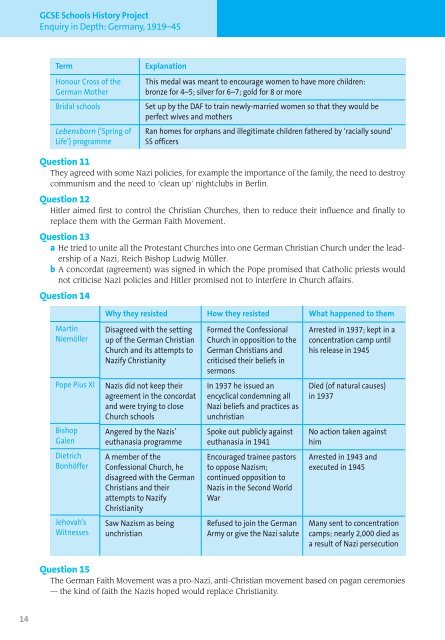GCSE Schools History Project Enquiry in Depth - Hodder Plus Home
GCSE Schools History Project Enquiry in Depth - Hodder Plus Home
GCSE Schools History Project Enquiry in Depth - Hodder Plus Home
Create successful ePaper yourself
Turn your PDF publications into a flip-book with our unique Google optimized e-Paper software.
<strong>GCSE</strong> <strong>Schools</strong> <strong>History</strong> <strong>Project</strong><strong>Enquiry</strong> <strong>in</strong> <strong>Depth</strong>: Germany, 1919–45TermHonour Cross of theGerman MotherBridal schoolsLebensborn (‘Spr<strong>in</strong>g ofLife’) programmeExplanationThis medal was meant to encourage women to have more children:bronze for 4–5; silver for 6–7; gold for 8 or moreSet up by the DAF to tra<strong>in</strong> newly-married women so that they would beperfect wives and mothersRan homes for orphans and illegitimate children fathered by ‘racially sound’SS officersQuestion 11They agreed with some Nazi policies, for example the importance of the family, the need to destroycommunism and the need to ‘clean up’ nightclubs <strong>in</strong> Berl<strong>in</strong>.Question 12Hitler aimed first to control the Christian Churches, then to reduce their <strong>in</strong>fluence and f<strong>in</strong>ally toreplace them with the German Faith Movement.Question 13a He tried to unite all the Protestant Churches <strong>in</strong>to one German Christian Church under the leadershipof a Nazi, Reich Bishop Ludwig Müller.b A concordat (agreement) was signed <strong>in</strong> which the Pope promised that Catholic priests wouldnot criticise Nazi policies and Hitler promised not to <strong>in</strong>terfere <strong>in</strong> Church affairs.Question 14Why they resistedHow they resistedWhat happened to themMart<strong>in</strong>NiemöllerDisagreed with the sett<strong>in</strong>gup of the German ChristianChurch and its attempts toNazify ChristianityFormed the ConfessionalChurch <strong>in</strong> opposition to theGerman Christians andcriticised their beliefs <strong>in</strong>sermonsIn 1937 he issued anencyclical condemn<strong>in</strong>g allNazi beliefs and practices asunchristianSpoke out publicly aga<strong>in</strong>steuthanasia <strong>in</strong> 1941Encouraged tra<strong>in</strong>ee pastorsto oppose Nazism;cont<strong>in</strong>ued opposition toNazis <strong>in</strong> the Second WorldWarArrested <strong>in</strong> 1937; kept <strong>in</strong> aconcentration camp untilhis release <strong>in</strong> 1945Pope Pius XINazis did not keep theiragreement <strong>in</strong> the concordatand were try<strong>in</strong>g to closeChurch schoolsAngered by the Nazis’euthanasia programmeA member of theConfessional Church, hedisagreed with the GermanChristians and theirattempts to NazifyChristianitySaw Nazism as be<strong>in</strong>gunchristianDied (of natural causes)<strong>in</strong> 1937BishopGalenDietrichBonhöfferNo action taken aga<strong>in</strong>sthimArrested <strong>in</strong> 1943 andexecuted <strong>in</strong> 1945Jehovah’sWitnessesRefused to jo<strong>in</strong> the GermanArmy or give the Nazi saluteMany sent to concentrationcamps; nearly 2,000 died asa result of Nazi persecutionQuestion 15The German Faith Movement was a pro-Nazi, anti-Christian movement based on pagan ceremonies— the k<strong>in</strong>d of faith the Nazis hoped would replace Christianity.14
















